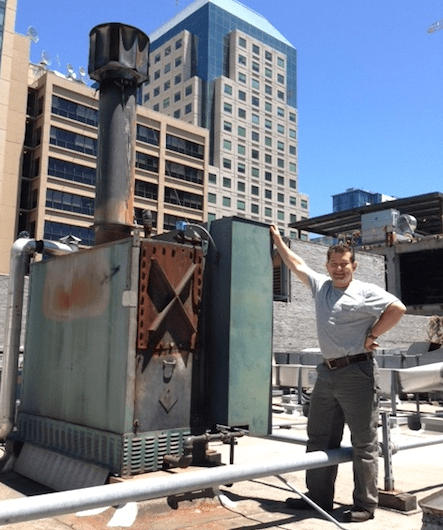Ever wonder how beer is made? We’re not talking just about hops, yeast, malted barley and water, but the actual process of brewing — and all of the points at which things can, and do, sometimes go terribly wrong? 
Brenden Dobel knows the answers. The brewmaster (and “certified cicerone“) at Thirsty Bear Brewery, a San Francisco-based organic micro-brewery says every step in the process, from cooking the raw ingredients to filling the cold taps that dispense the beer, is critical. Making beer, he explains, requires an extensive amount of mechanics, from refrigeration units, pumps and kettles to fermenters, air compressors and nitrogen generators. When any part of the system breaks down, beer production screeches to a halt — delaying deliveries and, worst case, spoiling the brew.
“Maintaining a brewery,” says Dobel, “is a never-ending process.”
Many Moving Parts
While we think of most American beers as ice-cold, it turns out that heat also plays an important role in brewing beer. The process of mashing — adding malted barley to water — creates a sticky, sweet liquid known as wort, which is then heated in a boiler.
Brewmasters, says Dobel, have a love-hate relationship with the boiler. It’s the heart of the operation — and it can be temperamental. When one breaks, “we’re like a ship in the water without a sail,” says Dobel. At $150,000 a pop, boilers require daily maintenance checks to make sure water levels are sufficient. If they drop, the results can be disastrous: a dry boiler will overheat, causing the metal to warp and the boiler to explode (for Thirsty Bear, the stakes are especially high: its boiler is located on top of a building). 
Once the boiler does its job, then comes another tricky part: yeast must be added to start the fermenting process. But because the boiling liquid can kill the live yeast, it has to be cooled. Enter air conditioning-like systems known as glycol units. If something goes wrong that Dobel’s crew can’t fix, HVAC field workers are called in.
Payoff: A Cold Pint at the End of the Day
In the end, Thirsty Bear’s elaborate system of moving parts and engineering makes a Rube Goldberg machine look like child’s play.
While Dobel went to school in Germany to learn the brewing trade and become a brewmaster, others on his team have been hired for years of experience, passion and mechanical aptitude. There are many routes to honing the brewing craft – what it comes down to for Thirsty Bear is passion and attention to detail. Dobel and his team have to solve problems fast, but at the end of a long day, there’s always an ice cold pint of beer waiting.

Share this: